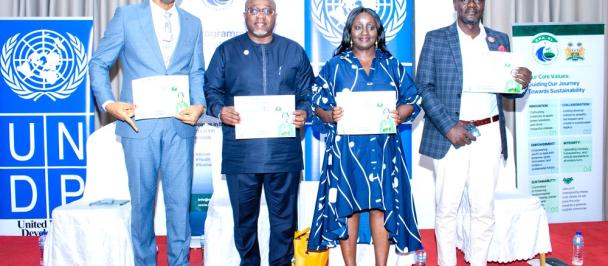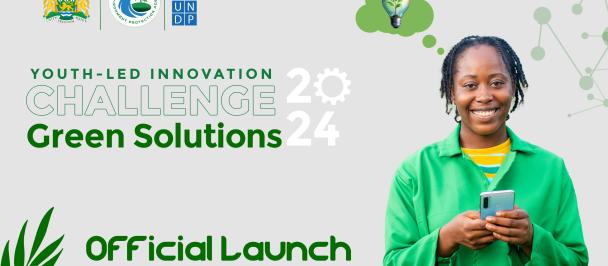By: UNDP Acclerator Lab Sierra Leone Team (Tuzlyn Bayoh, Head of Experimentation; Akinyemi Scott- Boyle, Head of Solutions Mapping and Benjamin Rogers, Head of Exploration) Samuel Mattia, Agriculture Engineer; Ramiz Uddin, Head of Experimentation,UNDP Accelerator Lab, Bangladesh and Sangita Paul, Research Officer, UNDP Research Facility, Bangladesh
Photo showing vegetables cultivating in a closed environment using hydroponic system Photo Credit: @ BD HYDRO.
Bangladesh is known to have flat fertile land apt for cultivating crops and vegetables all year round. However, with the rise in water levels, the southern regions of the delta are becoming less cultivation friendly. Dr. A F M Jamal Uddin, a professor of the Department of Horticulture at Sher-e-Bangla Agriculture University, has made progress in addressing the challenge with the use of hydroponics. According to the professor, the offsetting of the associated cost of the method can open possibilities for wide commercial usage.
In 1998, scientists at the Bangladesh Agricultural Research Institute conducted the first study on the meteorological and water potential of hydroponic farming in this country. In 2007, the study of hydroponic methods tailored to the climate of Bangladesh began with tomatoes, capsicum, lettuce, and strawberries. Another year later, in 2008, the team additionally experimented with cucumbers, marigolds and eggplants, and in 2009 dwarf beans, cauliflower, cabbage, broccoli and chrysanthemums. By 2012 the company produced tomatoes, capsicum, lettuce, strawberries, beans, cauliflower and cabbages.
Sierra Leone a country located on the West Coast of Africa is also known to have arable land and tropical climate with distinct wet and dry seasons. The wet season usually starts in May and ends in November, and is characterized by torrential rainfalls and high humidity. The dry season normally begins in December and ends in April, which includes harmattan, when cool, dry winds blow in from the Sahara Desert (changes in this weather partterns have aready been observed).
And as a result of this routine change in weather conditions, agricultural productivity levels also fluctuate. During the rains, farmers produce more as irrigation becomes easier and falls significantly during the dries. This instability contributes to widening the gap between local production and consumption, making food commodity one of Sierra Leone’s biggest import. It is reported that 80% of food commodities consumed in the country are imported, and the country continues to spend over $240 million annually on the import of rice alone[1].
Researchers over the years have been exploring ways and means to regulate and increase agricultural productivity, which includes establishing an all-year-round food production mechanism to help meet the needs of the current national population without adversely affecting the environment.
Our Tested Solution
Hydroponics is a type of horticulture and a subset of hydroculture where soil is replaced with substitute materials to support the plant's roots. Crops grow directly in nutrient-rich aqueous solvents. While there are multiple approaches to design hydroponic systems,in essence, it is a soil-less cultivation mechanism.
The Sierra Leone Experiment
UNDP Sierra Leone brought together a team of technical experts in Agriculture and Innovation to co-design the experiment, earmark specific challenge(s) that this solution can address, determining which of the SDGs the proposed solution contributes to identifying success/ failure indicators. The UNDP Accelerator deep dives with Agriculture Innovators - DSTI
As the proposed solution promotes indoor gardening amongst other benefits, a sample design of the indoor unit with funding from UNDP was built and installed at a hotel in Bo City, where the unit was monitored, and data was collected daily. Crisp Head Batavian Blonde de Paris Lettuce was nursed and grown to maturity under three (3) months, undergoing six (6) different stages. The Batavian Blonde de Paris has very crispy and sweet leaves. It is a type in between regular butterhead and iceberg lettuce. The leaves are compared to those of the Batavia lettuce.
The germination process was conducted outside the enclosure in a germination tray to provide an appropriate balance between the moisture and heat necessary for seeds to sprout. A tissue paper was used as a growing medium for germination and was placed at the bottom of the container and slightly wet with distilled water of pH 7.1. A slightly moist and heat conducive condition was created for germination to occur.
Photo showing vegetable grown from hydroponics system invented by a local inventor in Sierra Leone. Photo Credit: Samuel Mattia.
Key Outcomes
After sharing all data collected by the Sierra Leone Team with the Bangladesh Lab Team, including engaging in series of exchange sessions, we were able to identify the outcomes of this maiden experiment.
1) Soil grown Crisp Head Batavian Blonde de Paris Lettuce takes between 60 to 70 days to grow to full maturity, it was observed that the lettuce within the unit matured in 42 days indicating an increased growth rate of aproximately 35% with height and length of roots longer than average lettuce grown in Sierra Leone.
2) Absence of weeds and other soil-borne pests.
3) Water-savings was also recorded with better control over nutrient and oxygen culminating to increased crop quality, higher yields with minimal use of land space.
Now, with sea levels rising in the case of Bangladesh and change in weather conditions in the case of Sierra Leone threatening the traditional soil-based way of farming, reducing productivity at every turn and hindering each country’s drive to achieving food security by 2030, hydroponic technique needs to be considered/promoted (Hydroponics system in Bangladesh, based on floating gardens, has been recognized by the United Nations' Food and Agricultural Organization (FAO) as a Globally Important Agricultural Heritage System (GIAHS) for innovation, sustainability, and adaptability) for these reasons:
- Hydroponic technique allows increasing the yield of crops to ensure food security for the people, therefore advancing SDG Goal 2: Zero Hunger.
- Global warming is increasing at an alarming rate due to the increasing level of greenhouse gases, which will only become more evident in the future, as will its negative impact on farming. Hydroponics allows farming in a controlled area or system to ensure proper growth of crops achieving SDG Goal 13: Climate Action.
- There is a scarcity of land, water, and labor which are major hindrances to urban farming. Hydroponics system has the following benefits encouraging urban farming and moving towards achieving the SDG Goal 11: Sustainable Cities and Societies.
Both Country Accelerator Labs intends to share knowledge and collaborate with Government partners particularly the Ministry of Agriculture, Agricultural Research Insitiutes and Universities to explore means of introducing and integrating hydroponics farming methods extensively in 2022.
Photo showing of technical experts in Agriculture and Innovation who co-designed the experiment (Hydroponics) in Sierra Leone. Photo Credit: @Limkokwing University.

 Locations
Locations







